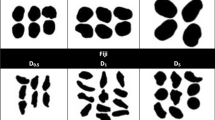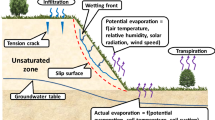Biopolymers, which are microbially induced polymers, can be used as an alternative material to improve engineering performance of soils. In this paper, a laboratory study of 0.075-1.0 mm size sand and biopolymer (i.e., xanthan gum) mixtures with various mix ratios (0%, 0.5%, 1.0%, and 1.5%) was performed. The materials, specimen preparation, and test methods are described, as are the results of a suite of permeability, odometer, unconfined compressive, and triaxial shear tests. The results suggests that specimen formation in the way used here could reduce permeability and increase compressibility, strength, and deformation characteristics in terms of stiffness.
Similar content being viewed by others
References
M. R. Hausmann, Engineering Principles of Ground Modification, McGraw-Hill Publishing Company, United Kingdom (1990).
M. Terashi and I. Juran, "Ground Improvement − State of the Art," International Conference on Geotechnical and Geological Engineering, 19-24 November, Australia (2000).
H. M. Lappin-Scott, F. Cusack, and J. W. Costerton, "Nutrient resuscitation and growth of starved cells in sandstone cores: a novel approach to enhanced oil recovery", Appl. Environ. Microbiol., 1373-1382 (1988).
F. A. Macleod, H. M. Lappin-Scott, and J. W. Costerton, "Plugging of a model rock system by using starved bacteria," Appl. Environ. Microbiol., 54 (6), 1365-1372 (1988).
S. K. Ramachandran, V. Ramakrishnan, and S.S. Bang, "Remediation of concrete using micro-organisms," ACI Mater. J., 98 (1), 3-9 (2001).
I. C. Y Yang, Y. Li, J. K. Park, and T. F. Yen, "Subsurface application of slime-forming bacteria in soil matrices," Applied Biotechnology for Site Remediation, Robert E. Hinchee et al. eds., CRC Press, Inc. 268-274 (1994).
S.W. Perkins, P. Gyr, and G. James, "The influence of biofilm on the mechanical behavior of sand," Geotech. Test. J., 23 (3), 300-312 (2000).
B. C. Martinez, J. T. DeJong, T. R. Ginn, B. M. Montoya, T. H. Barkouki, C. Hunt, B. Tanyu, and D. Major, "Experimental optimization of microbial-induced carbonate precipitation for soil improvement," J. Geotech. Geoenviron. Eng., 139 (4), 587-598 (2013).
O. Etemadi, I. G. Petrisor, D. Kim, M. W. Wan, and T. F. Yen, "Stabilization of metals in subsurface by biopolymers: Laboratory drainage flow studies," Soil Sediment Contamin., 12 (5), 647-661 (2003).
R. Khachatoorian, I. B. Petrisor, C. C. Kwan, and T. F. Yen, "Biopolymer plugging effect: Laboratorypressurized pumping flow studies," J. Pet. Sci. Eng., 38 (1-2), 13-21 (2003).
J. T. Dejong, M. B. Fritzges, and K. Nusslein, "Microbially induced cementation to control sand response to undrained shear," J. Geotech. Geoenviron. Eng., 132 (11), 1381-1392 (2006).
V. S. Whiffin, L. A. Van Paassen, and M. P. Harkes, "Microbial carbonate precipitation as a soil improvement technique," Geomicrobiol. J., 24 (5), 417-423 (2007).
A. Al-Qabany and K. Soga, "Effect of chemical treatment used in MICP on engineering properties of cemented soils," Geotechnique, 63 (4), 331-339 (2013).
M. B. Burbank, T. J. Weaver, T. L. Green, B. C. Williams, and R. L. Crawford, "Precipitation of calcite by indigenous microorganisms to strengthen liquefiable soils," Geomicrobiol. J., 28, 301-312 (2011).
M. Burbank, T. Weaver, R. Lewis, T. Williams, B. Williams, and R. Crawford, "Geotechnical tests of sands following bioinduced calcite precipitation catalyzed by indigenous bacteria," J. Geotech. Geoenviron. Eng., 139 (6), 928-936 (2013).
J. Mitchell and J. Santamarina, "Biological considerations in geotechnical engineering," J. Geotech. Geoenviron. Eng., 131 (10), 1222-1233 (2005).
V. Ivanov and J. Chu, "Applications of microorganisms to geotechnical engineering for bioclogging and biocementation of soil in situ," Rev. Environ. Sci. Biotechnol., 7 (2), 139-153 (2008).
A.F. Cabalar and H. Canakci, "Direct shear tests on sand treated with xanthan gum," Proc. ICE, Ground Improv., 164, No. 2, 57-64 (2011).
V. B. Bueno, R. Bentini, L. H. Catalani, and D. F. S. Petri, "Synthesis and swelling behavior of xanthanbased hydrogels," Carbohydr. Polym., 92 (2), 1091-1099 (2013).
I. Chang, A. K. Prasidhi, J. Im, H. D. Shin, and G. C. Cho, "Soil treatment using microbial biopolymers for anti-desertification purposes," Geoderma, 39-47 (2015).
D. Cole, D. Ringelberg, and C. Reynolds, "Small-scale mechanical properties of biopolymers," J. Geotech. Geoenviron. Eng., 138 (9), 1063-1074 (2012).
W. Schlesinger and A. Pilmanis, "Plant-soil interactions in deserts," Biogeochemistry, 42 (1-2), 169-187 (1998).
H. Khatami and B. O'Kelly, "Improving mechanical properties of sand using biopolymers," J. Geotech. Geoenviron. Eng., 139 (8), 1402-1406 (2012).
A. Bouazza, W. P. Gates, and P. G. Ranhith, "Hydraulic conductivity of biopolymer-treated silty sand," Geotechnique, 59 (1), 71-72 (2009).
D. Neupane, H. Yasuhara, N. Kinoshita, and T. Unno, "Applicability of enzymatic calcium carbonate precipitation as a soil-strengthening technique," J. Geotech. Geoenviron. Eng., 139 (12), 2201-2211 (2013).
B. M. Mortensen and J.T . DeJong, "Strength and stiffness of MICP treated sand subjected to various stress paths," ASCE GeoFrontiers 2011: Advances in Geotechnical Engineering, Geotechnical special publication 211, 4012-4020 (2011).
M. N. Ibragimov, "Characteristics of soil grouting by hydro-jet technology," Soil Mech. Found. Eng., 2013, 50, 200-205.
A.G. Malinin, Jet Grouting of Soils [in Russian], Moscow (2010).
T. R. Neu and K. C. Marshall, "Bacterial polymers: physicochemical aspects of their interactions at interfaces," J. Biomater. Appl., 5, 107-133 (1990).
P. Jansson, L. Kenne, and B. Lindberg, "Structure of the extracellular polysaccharide from Xanthomonas campestris," Carbohydr. Res., 45, 275-278 (1975).
R. A. Hassler and D. H. Doherty, "Genetic engineering of polysaccharide structure: production of variants of xanthan gum in Xanthomonas campestris," Biotechnol. Prog., 6, 182-187 (1990).
F. Garcia-Ochoa, V. E. Santos, J. A. Casas, and E. Gomez, "Xanthan gum: production, recovery, and properties," Biotechnol. Adv., 18, 549-579 (2000).
M. Milas and M. Rinaudo, "Properties of xanthan gum in aqueous solutions: role of the conformational transition," Carbohydr. Res., 158, 191-204, (1986).
C. S. H. Chen and E. W. Sheppard, "Conformation and shear stability of xanthan gum in solution," Polym. Eng. Sci., 20, 512-516 (1980).
P. A. Brandford and J. Baird, "Industrial utilization of polysaccharide," Aspinall, G.O. (ed.), The Polysaccharides, Vol. 2, 411-490, Academic Press, New York (1983).
ASTM D 2434-94. Standard test method for permeability of granular soils (constant head). Annual Book of ASTM Standards, American Society For Testing and Materials, West Conshohocken, PA (2000).
Author information
Authors and Affiliations
Additional information
Translated from Osnovaniya, Fundamenty i Mekhanika Gruntov, No. 5, p. 37, September-October, 2017.
Rights and permissions
About this article
Cite this article
Cabalar, A., Wiszniewski, M. & Skutnik, Z. Effects of Xanthan Gum Biopolymer on the Permeability, Odometer, Unconfined Compressive and Triaxial Shear Behavior of a Sand. Soil Mech Found Eng 54, 356–361 (2017). https://doi.org/10.1007/s11204-017-9481-1
Published:
Issue Date:
DOI: https://doi.org/10.1007/s11204-017-9481-1




